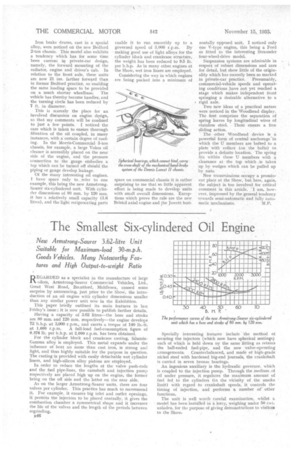The Smallest Six-cylindered Oil Engine
Page 72

If you've noticed an error in this article please click here to report it so we can fix it.
New Armstrong-Saurer 3.62-litre Unit Suitable for Maximum-load 3O-T11 .p .h. Goods Vehicles. Many Noteworthy Features and High Output-to-weight Ratio D EGARDED as a specialist in the manufacture of large oilers, Armstrong-Saucer Commercial Vehicles, Ltd., Great West Road, Brcutford, Middlesex, caused some surprise by announcing, just prior to the Show, the introduction at an oil engine with cylinder dimensions smaller than any similar power unit now in the Exhibition. This paper briefly outlined its main features in last Friday's issue ; it is now possible to publish further details. Having a capacity of 3.62 litres—the bore and stroke are 80 mm. and 120 mm. nespectively—the engine develops 72 b.h.p. at 3,000 r.p.m., and exerts a torque of 140 lb.-ft.
at 1,600 r.p.m. A full-load fuel-consumption figure of 11.378 lb. per b.h.p. at 2,000 r.p.m. has been obtained.
For the cylinder block and crankcase casting, SiluminGamma alloy is employed. This metal expands under the influence of heat no snore than cast iron, is strong and light, and thus highly suitable for the purpose in question. The casting -is provided with easily detachable wet cylinder liners, and high-silicon alloy pistons are employed. In order to reduce the lengths of the valve push-rods and the fuel pipe-lines, the camshaft and injection pump respectively are placed high up on the engine, the former being on the off side and the latter on the near side.
As on the larger Armstrong-Saucer units, there are four valves per cylinder. This practice has much to recommend it. For example, it ensures big inlet and outlet openings, it permits the injectors to be placed centrally, it gives the combustion chamber a symmetrical shape and it increases the life of the valves and the length of the periods between regrinding.
Specially interesting features include the method of securing the injectors (which now have spherical seatings) each of which is held down by the same fitting as retains the ball-ended fuel-pipe, and the new valve-operating arrangements. Counterbalanced, and made of high-grade nickel steel with hardened big-end journals, the crankshaft is carried in seven bronze bearings.
An ingenious auxiliary is the hydraulic governor, which is coupled to the injection pump. Through the medium of oil under pressure, it regulates the maximum amount of fuel fed to the cylinders (in the vicinity of the smoke limit) with regard to crankshaft speeds, it controls the timing of injection, and performs a number of other functions.
The unit is well worth careful examination, whilst a model has been installed in a lorry, weighing under 50 cwt. unladen, for the purpose of giving demonstrations to visitoriis to the Show.






















































































































